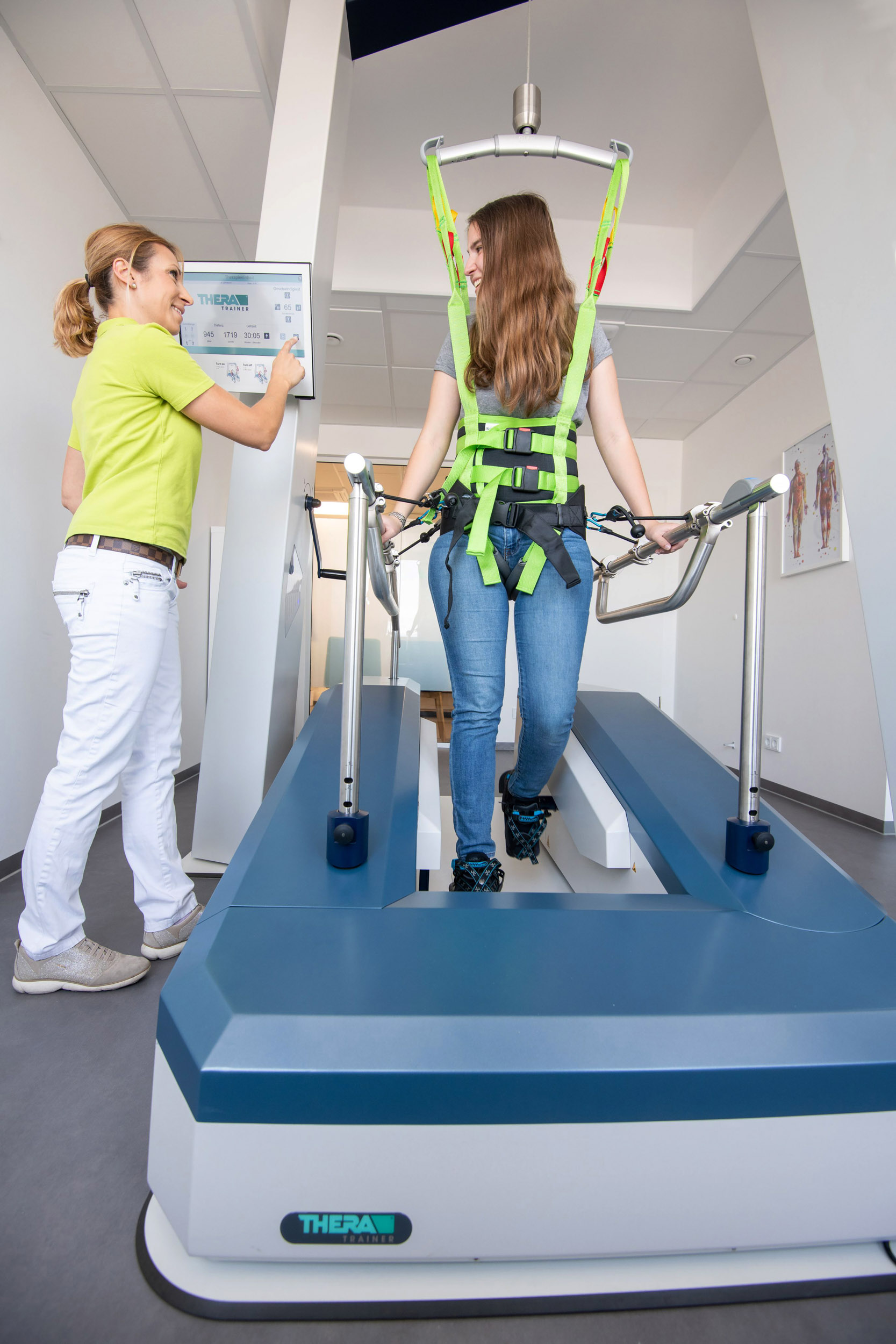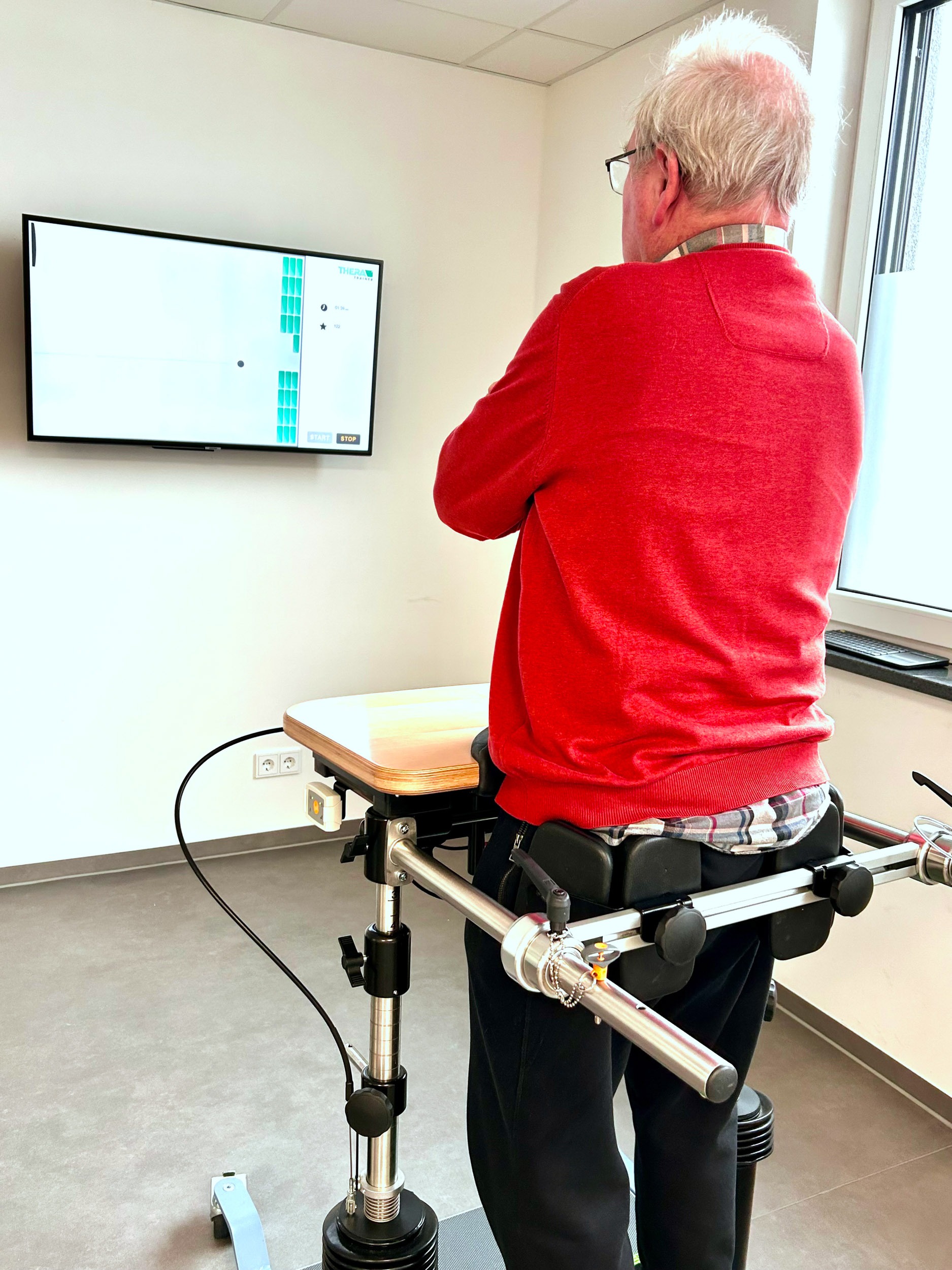
Discover how erGO konzept in Straubing combines state-of-the-art robotic and computer-assisted therapy with evidence-based group treatment to improve mobility, balance, and independence in neurological patients.

The use of high-quality rehabilitation equipment opens up promising therapeutic options for patients. With this unique overall solution, the erGO konzept maximises the chances of success, helping patients achieve the best possible rehabilitation. The combination of state-of-the-art technology and classic therapy methods offers a comprehensive and effective approach to improving the quality of life and independence of people with neurological conditions.
Kathrin Neißendorfer: The name erGO konzept has evolved from the key elements of our philosophy. When I was looking for a suitable name for the practice, it was important to me to incorporate ‘GO’ – representing walking – as gait therapy is a central component of our concept. After a bit of pondering, it was a surprisingly obvious choice, as ‘ergo’ already contains ‘go’ (laughs). That’s where the name came from, and that’s what we’re all about. I feel that it’s a creative name that emphasises the connection to gait, balance and postural control therapy as important therapeutic approaches, while at the same time symbolising the clear focus on modern occupational therapy.
Interviewer: What is the overriding objective of erGO konzept?
Kathrin Neißendorfer: Our aim is to help patients re-learn lost skills and maintain existing ones so they can be as independent as possible and participate in social life. The plasticity of the brain means that nerve connections can be rebuilt even after severe damage. This is precisely where our occupational therapy treatment comes in, to compensate for functional deficits. We use state-of-the-art methods to maximise the chances of success for patients for the best possible rehabilitation. The external focus of computer-assisted therapy is not just an important aspect in terms of motor learning, but also ensures a high level of motivation and enjoyment during therapy.
Interviewer: Which specialities do you cover, in addition to neurology?
Kathrin Neißendorfer: We are a specialist practice for neurology and orthopaedics. Patients of all ages are at the heart of orthopaedics. We treat congenital disorders of the musculoskeletal system, as well as disorders caused by accidents or chronic illnesses. Our aim is to strengthen muscles, maximise mobility and reduce pain. One major area is hand rehabilitation. In the paediatrics department, specially trained therapists treat children and adolescents on a different floor. We treat children and adolescents with delayed or limited development of perception or motor skills, as well as attention problems or unclear handedness.
Kathrin Neißendorfer: We offer specific therapy for patients with symptoms of dizziness and vestibular migraines. As dizziness and vestibular therapists certified by the Institute for Vestibular Rehabilitation Therapy (IVRT), we achieve amazing and – most importantly – rapid results through individualised exercises in vestibular rehabilitation. Patients who previously had little professional support have been able to reduce their dizziness symptoms in our practice, as well as through personalised exercises at home, enabling them to participate in social life again without balance problems and gait insecurity.
Interviewer: And how does neurofeedback work?
Kathrin Neißendorfer: Neurofeedback aims to improve processing in the brain. EEG measurements are used to analyse individual brain waves, compare them with standard databases and transmit the brain activity to a screen in real time (feedback). The training is based on operant conditioning. In our practice, patients are offered a video of their choice. If successful, i.e. if the brainwaves approach the norm or increase or decrease in intensity, the patient receives a reward in the form of a sharp, bright image. If the brain waves deviate too much or if certain waves dominate (which could be the cause of the relevant symptoms), the patient experiences a “reprimand” in the form of a dark screen. This stimulates the brain to adjust its activity so that the film can be watched without any disturbing factors. Neurofeedback therapy is suitable for ADHD, epilepsy, autism, depression, sleep disorders, anxiety, burnout, migraines, memory disorders and long COVID.

Kathrin Neißendorfer: We offer intensive treatment for stroke patients, focusing on gait therapy and the upper extremities. Patients with multiple sclerosis, Parkinson’s disease, rare neurological diseases, and dizziness and gait abnormalities in old age also attend our practice. The focus is on maintaining and regaining motor skills after central lesions.
Interviewer: Which devices are used in therapy?
Kathrin Neißendorfer: The lyra end-effector gait trainer from THERA-Trainer is at the heart of our approach. We also use the 3D Spacecurl, Posturomed and the THERA-Trainer balo to train postural control and coordination. The THERA-Trainer tigo is used for strength, endurance and mobility, while the Hand-Arm and 3D Tutor are used for upper limb training. The training usually takes place in individual and group settings and is supplemented by conventional therapy methods as required.
Redaktion: Which factors are most important for the success of the therapy?
Kathrin Neißendorfer:In our practice setting, we create therapy situations that promote learning, particularly as part of group training. The modern therapy devices, some with biofeedback and therapy games, motivate patients and provide feedback on their successes. The equipment enables a high training intensity and number of repetitions, which is crucial for the motor learning process. The requirements are determined individually and increased over the course of the programme. The therapy has significant practical relevance, as the majority of patients are highly motivated to carry out the exercises on their own at home, leading to faster improvements such as increased independence in their daily lives.
Interviewer: What conclusions have your drawn from the successes of the erGO konzept?
Kathrin Neißendorfer:The computer and device-assisted therapies represent added value for patients and therapists. We achieve more effective treatment progress and success in less time. Our practice is not only clinically effective but also an economic success. This clearly shows that with a well-conceived plan and the right level of investment, you can achieve success and inspire patients even in outpatient rehabilitation. We started with 120 square metres and gradually built up. We now have around 400 square metres of therapy space, currently spread over 3 floors. We offer services across specialised fields. There’s a practice for neurofeedback and brain performance training, the original practice for neurological and orthopaedic patients, and the Kirchroth site with paediatrics also recently moved to Straubing.
Redaktion:Thank you, Kathrin, for an exciting insight into this modern form of occupational therapy. And good luck for the future!


Related contents
Find related exciting contents in our media library.
Meet our specialists.
Are you interested in our solutions? Schedule a meeting with a Consultant to talk through your strategy and understand how TEHRA-Trainer can help you to advance rehabilitation.
You need to load content from reCAPTCHA to submit the form. Please note that doing so will share data with third-party providers.
More InformationYou are currently viewing a placeholder content from Turnstile. To access the actual content, click the button below. Please note that doing so will share data with third-party providers.
More Information